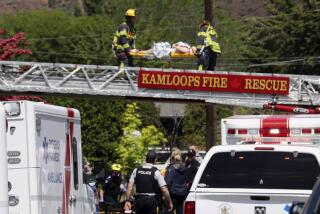Airdrop Chokes Up South Pole Scientists
- Share via
WASHINGTON — The drop of emergency medical supplies for a woman at the South Pole was an emotional moment for others at the science station as well.
“The aircraft was low enough that I actually saw a person at the side cargo door, arms and legs spread out, braced . . . another human being, a stranger, in our world,” writes Joel Michalski, a NOAA Corps officer stationed at the pole.
“I was choking on the emotion,” Michalski says in an e-mail posted on the Internet page of the National Oceanic and Atmospheric Administration.
The airdrop last weekend was needed to provide medical supplies to a 47-year-old woman, whose name was not disclosed, who had discovered a lump in her breast. No further details of the woman’s condition were provided.
Because of the extreme cold and bad weather, the plane could not land and people at the station have no way to get out until winter ends in October.
The 22-member flight crew returned to a hero’s welcome Friday at McChord Air Force Base near Tacoma, Wash.
Crew members said the dangerous mission in bitter cold and darkness--water bottles froze in the cockpit and the people pushing supplies out the doors battled wind chills of 150 degrees below zero--was worth it.
“Maybe we’ll get a chance to meet her,” Senior Master Sgt. Ed Saurs, who supervised the drop, said after the crew stepped onto the tarmac.
Michalski, from Weston, Wis., is in charge of the climate monitoring station that NOAA operates year-round at the Antarctic observatory. He collects and sends data to NOAA’s Climate Diagnostic Laboratory in Boulder, Colo.
“Some days stand out in each of our lives. For me, Saturday night will rank as one of the most memorable and perhaps mark a defining moment,” Michalski writes.
Here is his description of the air drop and recovery of the supplies:
“At this moment we had 27 ‘smudge pots’ patterned in the shape of ‘C’ marking the intended drop zone, a 3,000-foot section of the summer airplane ski way. The smudge pots, constructed from half barrels and filled with wood and gasoline, were ignited, creating a bright, flaming marker.
“The rest of the outside lights around station were turned off so the pilot would not mistake stray lights for the actual drop zone.
“At 10:30 p.m., the C-141 was in sight and a minute later it roared overhead, only 700 feet above the snow surface! It dropped two packages on the first fly-by, turned around and dropped four more and departed immediately, the whole operation taking less than ten minutes!
“The aircraft was low enough that I actually saw a person at the side cargo door, arms and legs spread out, braced against each side of the door frame, body silhouetted by light from inside the plane, he was obviously looking down to us, and we up to him.
“It was another human being, a stranger, in our world. That moment I realized how long I had been away, how much I have changed, and that part of me, despite all this communication, that will never be understood by anyone who hasn’t been here for a winter. I was choking on the emotion.
“There was no time to sit and think. As soon as the Starlifter departed we ran out to the drop zone to retrieve the six packages. It was extraordinarily difficult to find anything, the flashing strobe lights and chemical glow patches affixed to each box extinguished immediately in the -86 F air temperature.
“We had spotters watching from the highest structures around station and were fortunate to find five boxes immediately, but it took us one and a half hours to find the sixth box! I must have walked five miles over the snow surface with dozens of other people, searching back and forth for this missing box. It was finally found and we all headed inside.
“Inside the new garage the boxes were disassembled and contents laid out for inventory. The box that made us the most happy was the one filled, actually PACKED, with fresh fruit and vegetables. Some of the fruit was crushed from the fall so people were grabbing up samples to taste and relish!
“The rest of the evening was more like a party. One box had fresh cut flowers for the woman in question and another box had the entire flight crew’s signatures and well wishes written all over one side! More emotions welled up when I saw this.
“Finally, at about 2 a.m., people rested for the night.”
NOAA Corps is the nation’s smallest uniformed service. It’s 400 officers operate ships and aircraft doing climate research and fisheries analysis and enforcement. It was founded as the Coastal Survey under President Jefferson.
More to Read
Sign up for Essential California
The most important California stories and recommendations in your inbox every morning.
You may occasionally receive promotional content from the Los Angeles Times.













